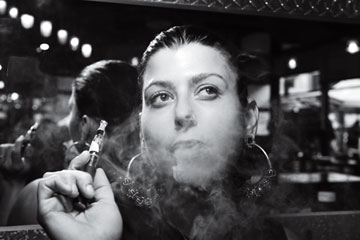
"Vapers or Smokers?" Is the question Spike Babaian, the owner of VapeNY, an electronic-cigarette store on the Lower East Side of Manhattan, asks the stream of new customers who walk through the door. A former gender-and-sexuality professor with a smoker's throaty voice and a spiked black leather collar tight around her neck, Babaian, like most early adopters of electronic cigarettes, is a little eccentric. But the customers in her busy store are all kinds of people--two sisters in their late 50s, a mother with her husband and children in tow, a young Asian woman in a silk blouse and a French freelance journalist in his 30s.
There are roughly 44 million smokers in the U.S., and according to the Centers for Disease Control and Prevention (CDC), about 1 in 5 of them has tried electronic cigarettes. The rate of use is ever so slightly higher among non-Hispanic white men and women ages 45 to 54 in the South, but electronic cigarettes appeal to anyone who wants the look and feel of smoking but wants to be able to do it indoors and when they go out with friends--without the stigma, the smell and the yellow teeth. For pack-a-day smokers who switch entirely, the e-cigarette is cheaper. They hope that, without smoke and tar, it is healthier too.
Babaian is determined to "convert"--her term--as many smokers to vapers as she can, and like a pharmacist, she guides them. They smoke a pack a day? They'll need a bottle with 16 mg of nicotine. She teaches them to press the button as they inhale, telling them to take a longer pull because the vapor isn't as hot as burning tobacco. The device, which looks like a miniature flute, heats a tiny metal coil, which then vaporizes the nicotine liquid. If a customer balks at the $38 price for the refillable electronic cigarette, which includes an atomizer, a rechargeable battery and a charger, she reminds them that it's a savings. An $8 bottle of liquid lasts a pack-a-day smoker about a week. In New York City, a vaper on Spike's product would spend $40 to $50 a month on liquid and replacement parts, much less than a pack-a-day cigarette smoker, who'd spend that amount in four days.
The e-cigarette market has grown from $300 million in retail sales in the U.S. last year to an estimated $1.8 billion in 2013, according to Bonnie Herzog, senior analyst at Wells Fargo. E-cigarettes are sold at Walmart, vaped by Katherine Heigl and Leonardo DiCaprio and advertised during the Super Bowl and the Oscars and on the hoods of NASCAR race cars. But much of their early success comes thanks to their near complete freedom from regulation, which has allowed dozens of small players to flourish.
That is about to change. The tobacco giants Lorillard, Reynolds American, Altria and British American Tobacco have just entered the market. And the Food and Drug Administration says it intends to assert control over e-cigs in October--kicking off a rules-writing process that could regulate everything from manufacturing to the nicotine content to whether or not electronic cigarettes can be flavored, sold online, sold to kids or marketed on television. At the same time, cities and states across the country are considering laws like sales taxes and bans in public places.
